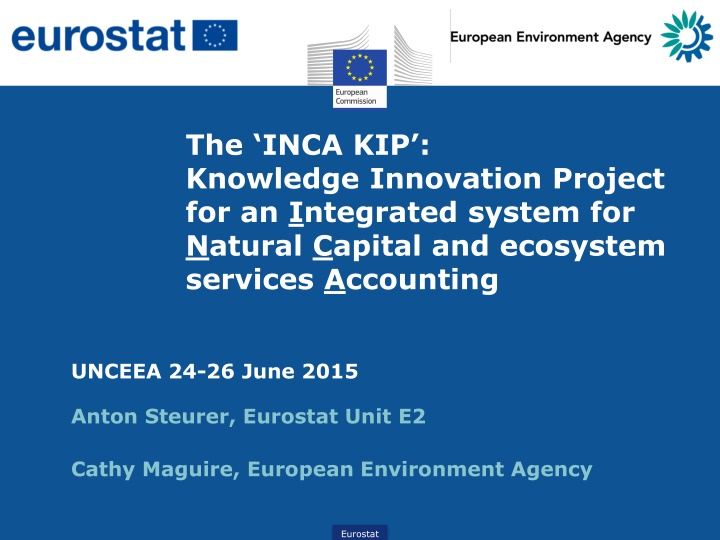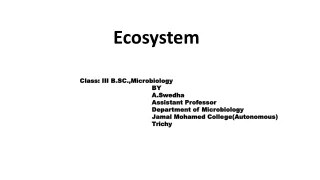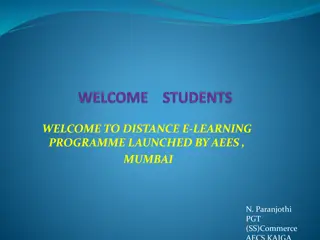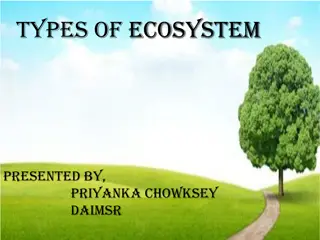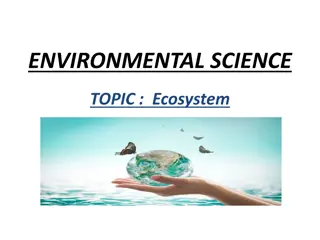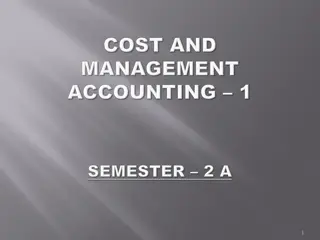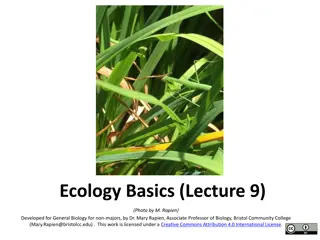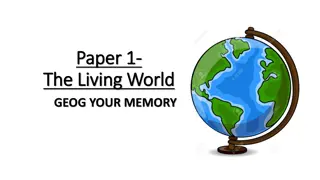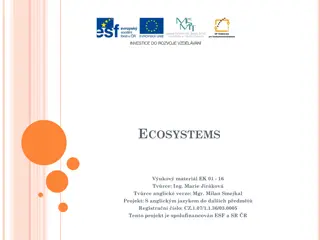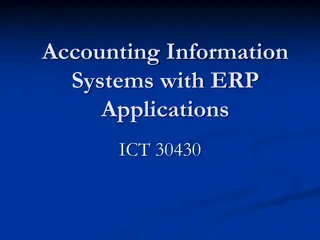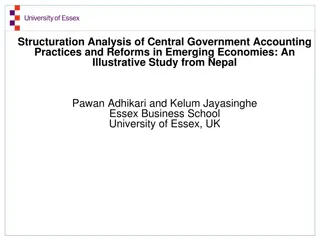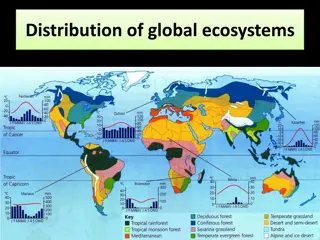Accounting for Ecosystems at EU Level: Challenges and Innovations
Meeting the demands of accounting for ecosystems at the EU level involves integrating natural capital into reporting systems, conducting valuation studies, and building a knowledge base. This requires biophysical accounts, EU data layers, accounting experiments, and stepwise standards. The challenge lies in the disjointed and costly data collection efforts that do not effectively measure ecosystems, using methods such as ground observations, satellite images, biodiversity monitoring, and various statistical reports.
Download Presentation

Please find below an Image/Link to download the presentation.
The content on the website is provided AS IS for your information and personal use only. It may not be sold, licensed, or shared on other websites without obtaining consent from the author.If you encounter any issues during the download, it is possible that the publisher has removed the file from their server.
You are allowed to download the files provided on this website for personal or commercial use, subject to the condition that they are used lawfully. All files are the property of their respective owners.
The content on the website is provided AS IS for your information and personal use only. It may not be sold, licensed, or shared on other websites without obtaining consent from the author.
E N D
Presentation Transcript
The INCA KIP: Knowledge Innovation Project for an Integrated system for Natural Capital and ecosystem services Accounting UNCEEA 24-26 June 2015 Anton Steurer, Eurostat Unit E2 Cathy Maguire, European Environment Agency Eurostat
The EU policy context EU Biodiversity Strategy to 2020: Action 2 Mapping and Assessment of ecosystems & their services (->MAES) Integrate natural capital into accounting and reporting systems (valuation) EU 7th Environmental Action Programme to 2020 Living well, within the limits of our planet : Objective 1: 'protect, conserve and enhance the European Union s natural capital' Objective 5: build environmental knowledge base Environment Knowledge Community at EU level to support knowledge base -> EU project on natural capital and ecosystem services 2
International & EU guidance documents United Nations, European Commission, FAO, IMF, OECD and World Bank (2013): System of Environmental-Economic Accounting 2012 Central Framework. (International Statistical Standard) United Nations, European Commission, FAO, OECD and World Bank (2014): System of Environmental-Economic Accounting 2012 - Experimental Ecosystem Accounting. http://unstats.un.org/unsd/envaccounting/seeaRev/eea_final_en.pdf European Commission (2013): Mapping and Assessment of Ecosystems and their services http://ec.europa.eu/environment/nature/kno wledge/ecosystem_assessment/pdf/MAESWor kingPaper2013.pdf 3
What do we need for accounting for ecosystems (at EU level)? We need biophysical accounts for direct use as a basis for valuation studies, upscaling We need an EU data layer of accounts as a frame for countries and for responding to EU policies foundation for building input data layers and the capacity to analyse accounting results We need accounting experiments & demonstrations building the case for ecosystem capital We need stepwise standards & recommendations towards a common methodology => Knowledge innovation project ('KIP') on natural capital and ecosystem services 4
What is the challenge? Many different & separate & expensive data gathering exercises but not really tailored towards measuring ecosystems LUCAS (ground observation) COPERNICUS (satellite images) Biodiversity monitoring Corine Land Cover Forest statistics Water FD reporting Farm Structure Survey (agricultural census) Natura 2000 data Et cetera 5
What is the potential solution ? Goal: nested and connected data sets in a common frame: the foundation for an Integrated system for Natural Capital and ecosystem services Accounting - based on statistical and geospatial information Land use/cover data Ecosystem data Land use data Natura 2000/CDDA FSS Bio-energy Forest stats LUCAS Ecosystem mapping (extent) Copernicus Land monitoring In situ coordination Ecosystem condition (state) Biodiversity assessments (monitoring) 6
Setting up a better functioning system - KIP on Natural Capital and ecosystem services Accounting Tasks identified: - Identify the required information - - Develop an integrated data collection system - - Set joint minimum data standards (e.g. on geo- referencing) - Establish a shared data platform - Integrate all available data and make sure new data fit into the system (-> it becomes better and better) 7
Activities of Eurostat and EEA Eurostat activities useful for the KIP - Works on geospatial-statistical data integration, involved in UN-GGIM. Runs the LUCAS survey, an EU-wide area-based sampling survey where approx million points are visited in the EU and land use, land cover, linear features are assessed and soil samples are taken Runs with Member States large geo-referenced surveys agricultural and population censuses Involved in environmental-economic accounting - - - 8
Activities of partners cont. EEA activities useful for the KIP: - Involved in MAES (mapping of ecosystems) - Very strong role in Copernicus = remote sensing - Work on land accounts and ecosystem accounts since many years. Current focus is component accounts for land, water, biomass carbon and a landscape/species account. - EEA helped develop CICES - released v 4.3 in January 2013. Plan discussed with UNSD is to start a review in summer 2015 including links to the US-EPA FEGS system. - Review of data needs and data availability for ecosystem accounting: overviews of data sets relevant for natural capital accounting elaborated. Ongoing work on further developing data layers and information on ecosystem extent and condition in Europe (in the context of MAES). - Environmental interpretation of ecosystem accounting results: comprehensive assessment experience 9
Steps in the INCA KIP - Scoping paper and a roadmap was approved by the Directors General of the involved institutions on 13 May 2015 The first phase will be a feasibility and design phase, focusing on identifying user needs and source data, design the accounts, detailed planning and budgeting this phase will be covered by already available resources of partners On that basis decision by the Directors General to go ahead or not, including allocation of budget for implementation The second phase (implementation) is expected to need about 4-5 years and should result in regular compilation and dissemination of basic ecosystem accounts for the EU from approx. 2020 onwards. - - - 10
Summing up - A key idea is data integration which allows making use of existing data, exploiting the strengths of each approach. Capitalise on expertise and data available at key partners, incl. accounting, monitoring, analysis and modelling Strategic component: gradually, different approaches (such as LUCAS) can be tailored towards better contributing to ecosystem accounting EU level data sets are integrated by EU level bodies no extra work for MS but opportunity to plug in Response to clear EU policy targets and international developments Two main phases first feasibility and design 2015-2016, if 1st phase successful: implementation till 2020 Project success requires: producing results that are fit for purpose, dealing with data uncertainties incl. error propagation in systems that use overlays of georeferenced data, keeping system complexity manageable - - - - - - 11
